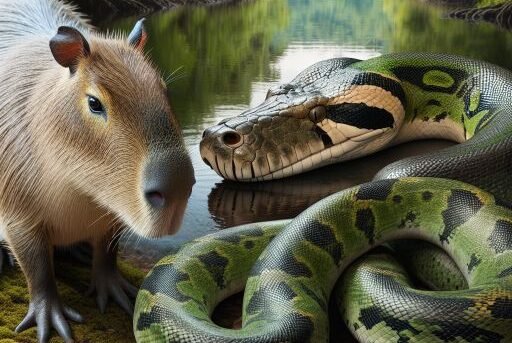Location and Habitat
The anaconda, one of the largest and most powerful snakes in the world, thrives in the dense and humid rainforests of South America. Primarily found in the Amazon and Orinoco basins, these formidable reptiles are perfectly adapted to life in and around water bodies such as swamps, marshes, and slow-moving rivers, where they blend seamlessly into the murky waters to ambush prey.
On the other hand, the capybara, the world’s largest rodent, is also native to South America, inhabiting similar regions as the anaconda but with a preference for densely vegetated areas near bodies of water, including rivers, lakes, and swamps. These social creatures live in groups and are well adapted to an aquatic lifestyle, with webbed feet that aid in swimming and the ability to stay submerged for up to five minutes to evade predators.
Anaconda vs. Capybara Comparison
| Animal | Size and Weight | Ability to Finish Opponent | Weaponry |
|---|---|---|---|
| Anaconda | Up to 550 lbs (250 kg), 20-30 ft (6-9 m) long | High; uses constriction to suffocate prey | Powerful muscular body, sharp teeth |
| Capybara | Up to 145 lbs (66 kg), 4 ft (1.2 m) long | Low; primarily a prey species | Strong teeth for grazing |
“`
Hunting and Skills
Anacondas are formidable predators that primarily hunt in water, using their powerful bodies to constrict and drown their prey, which includes capybaras, caimans, and even jaguars on rare occasions. They rely on stealth and strength to ambush their targets, often waiting submerged in murky waters to strike unexpectedly. Capybaras, on the other hand, are large herbivores and the primary prey of many predators, including anacondas. They feed on grasses and aquatic plants and have adapted to a semi-aquatic lifestyle to evade predators. Capybaras are skilled swimmers, which can sometimes help them escape from predators like anacondas. They also use their sharp senses to detect threats and often reside in groups to enhance their chances of survival through collective vigilance.
Anaconda vs. Capybara Who Would Win?
The anaconda attacks by coiling around the capybara, aiming to constrict. The capybara struggles to escape, using its teeth to bite. The anaconda’s strength and size give it an advantage. The capybara’s efforts are insufficient against the anaconda’s grip. The anaconda eventually overpowers and suffocates the capybara.
Winner: Anaconda with an 85% chance of winning.




